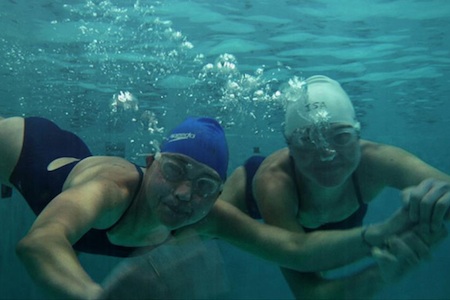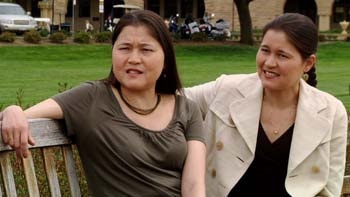As a longtime member of the San Francisco Bay Area filmmaking community and an in-demand consultant to media and technology companies, Marc Smolowitz has worn many a hat—from distributor’s deerstalker (with Turbulent Arts) and educator’s escoffin (currently at UC Santa Cruz and The Art Institute of California, San Francisco) to producer’s pillbox (on Sandi DuBowski’s Teddy-winning Trembling Before G-d and Sam Green’s Academy Award–nominated The Weather Underground) and fundraiser’s fedora (for Access San Francisco and a host of worthy nonprofits)—and they all match perfectly with his customary horn-rimmed glasses. To this list of headwear Smolowitz must now add the director’s beret, having helmed the award-winning documentary feature The Power of Two. It’s an extraordinarily moving account of half-Japanese twin sisters Anabel and Isabel Stenzel, both of whom have battled cystic fibrosis, undergone double lung transplants and triumphantly thrived as Stanford students, competitive athletes and organ-donation activists. Early in the film the Stenzels testify to the importance of gaman, a Japanese term of Zen Buddhist origin meaning perseverance, and it is with this remarkable inner strength that the siblings face their medical challenges and Smolowitz approaches his storytelling art. On a recent sunny summer morning, the seasoned multitasker refused to let a pesky cold stop him from thoughtfully discussing documentary approaches, social-issue advocacy, and the camaraderie of the local filmmaking community from his home in San Francisco.
[Editor’s note: The Power of Two is executive-produced by Chris Kelly, Facebook’s first Chief Privacy Officer and a member of Fandor’s board.]
Keyframe: How were you initially drawn into the lives of the Stenzel sisters, and what was it about their story that spoke to you as a filmmaker?
Marc Smolowitz: I met Andrew Byrnes, my producing partner on the film [and Isabel Stenzel’s husband], through the philanthropy organization Full Circle Fund. Andrew knew of my work as a film producer, and he alerted me to the fact that the twins had a book [The Power of Two: A Twin Triumph over Cystic Fibrosis], were going on a speaking tour in 2009 and wanted to turn their project into something even more ambitious. I was intrigued, and when I read their book it sealed the deal for me. I realized that this would be my next project and something quite substantial. That was a tough year for the economy, but we managed to complete the initial production cycle in Japan.
Keyframe: Had you determined the shape of the film prior to that first trip to Japan? And were you welcomed as an American filmmaker investigating the somewhat taboo topic of organ donation?
Smolowitz: I wasn’t quite sure how the film was going to develop, but the trip to Japan opened up many different story points, and it was so powerful being there with Ana and Isa and seeing them in action as patient advocates, which is not common in Japan. From that point on I envisioned the film as a cross-cultural effort, one that would encompass the twins’ love of their mother’s country and the issues surrounding cystic fibrosis and organ donation both in the U.S. and Japan. Ana and Isa became bigger-than-life spokeswomen. They were able to help change cultural attitudes toward organ donation and to make it an important public topic, which is difficult because people don’t talk about health issues as openly there as they do here. In Japan, there’s a stigma around disability and living with disease.
The interviews were challenging because I was dealing with a different culture and language, and I had to rely on an interpreter. Some of the interviews were very emotional for people, like the woman who lost her child because organ transplant wasn’t available. I did my best to take plenty of time with each subject, and to make them feel comfortable.
Keyframe: How did the project continue once you returned to the States?
Smolowitz: We attended key events in the cystic fibrosis and organ transplant communities, such as the Transplant Games of America, where we had a huge presence not just as a film crew but also as an advocacy group. We got on everyone’s radar and built an entire infrastructure beyond the film, which I knew could be used to further the goals of a variety of stakeholders. I worked very closely with a lot of nonprofits during production, which was a very effective way of getting things done. And all along I wanted the film to speak to more than just the cystic fibrosis and organ donor communities.
Keyframe: What is the most effective means of breaking through to that larger audience?
Smolowitz: I’m totally committed to the idea that character-driven documentaries can change hearts and minds about important issues. In thinking about the genre of social-issue filmmaking, I knew that I wanted to focus on people first and foremost. Ana and Isa are completely relatable, and hopefully you feel like you could have grown up with them and gone to high school together. They both have had ordinary yet also extraordinary lives, and by highlighting their personal stories I hope that viewers can connect to them and to their specific issues.
Social-issue filmmaking has changed over the years. In the ’90s the focus was on personal stories, then in recent years we’ve had more films like The Cove, big polemic films with high production values. Why can’t we have a bit of both? I want the personal to be at the center and to make the polemic more approachable for viewers.
Keyframe: At a key moment in the film Isa says, ‘Storytelling is how you change people.’ This could be the documentary filmmaker’s credo as well. Has advocacy through filmmaking always been important to you?
Smolowitz: My approach has evolved over the years, and now I am most at home when focusing on advocacy as a major part of social-issue films. There have been other films on the topic of organ donation, but I saw The Power of Two as a way to showcase the entirety of the issue and to really help viewers understand what it’s all about. I’m striving for the three “E”s; educate, enlighten, and entertain. The film really seems to work on all of these levels, as I’ve seen from audience responses.
Keyframe: How did you develop the film’s visual style?
Smolowitz: I collaborated with an amazing director of photography, Nickolas Rossi, and we brought in various aspects of the twins’ lives into the visuals. They love to blow bubbles [as a way to honor organ donors and their families], which I discovered early on as a visual motif; it’s so cinematic. And we incorporated their family photo albums, their childhood diaries, VHS footage of a news program they appeared on when they were younger. The physical evidence of their lives had to be portrayed.
Ana and Isa became bigger-than-life spokeswomen. They were able to help change cultural attitudes toward organ donation and to make it an important public topic, which is difficult because people don’t talk about health issues as openly there as they do here. In Japan, there’s a stigma around disability and living with disease
Keyframe: Including scars from their operations, in one particularly candid scene.
Smolowitz: Initially they told me that they would show their scars, but as that day of the shoot approached they began to get a bit nervous about it. Finally they just went for it, they were ready.
Keyframe: Just as it seems you were ready, with this project, to take on the directing role for the first time. How did your experience as a producer on films by Sandi DuBowski and Sam Green help prepare you for this big step?
Smolowitz: We’re all constantly working with amazingly talented folks, and in general I think that we all draw from each other. I’m sure that Sandi and Sam, and many other people, have added to my own filmmaking vocabulary. I worked with Rob Epstein and Jeffrey Friedman in the early ’90s, and they were certainly helpful as well.
My journey from first working with festivals, then in distribution, then to producing, led me to the moment when I feel ready to be in that creative role, now more than ever. I’ve had a comprehensive experience in the film industry that has given me a sense of how to tell a good story.
Keyframe: You’ve recently also applied these learnings to Still Around, a compilation of short films about people dealing with HIV/AIDS.
Smolowitz: Still Around is part of the HIV Story Project, which also includes a video storytelling booth and major community efforts. It’s been very powerful for me to work on a film about cystic fibrosis and organ donation on one hand, and projects dealing with HIV and AIDS on the other. In both cases, patients and their families, along with activists, have rallied for support and to find their own treatments and cures.
Keyframe: What’s next for you?
Smolowitz: I’m still completely involved with these two projects. We’re returning to Japan in October for the theatrical release of The Power of Two [it premiered at the 2011 Tokyo International Film Festival, subsequently screened at nearly thirty fests and is now launching digitally and on DVD]. As for the HIV Story Project, we’ve been invited to present all of the work at the International AIDS Conference in July. My next film will be The Beachhead, a documentary about the child welfare system in America.
Keyframe: Are you planning on staying in the Bay Area, or might filmmaking take you elsewhere?
Smolowitz: I’ve lived in San Francisco for 22 years. This is my home. There is such a large and robust community of filmmakers here in the Bay Area. Docs do well here. The challenge for local filmmakers now is to distinguish their work from all of the user-generated content about social issues. I want to stay here and do that, make unique work about issues that are important to me.





